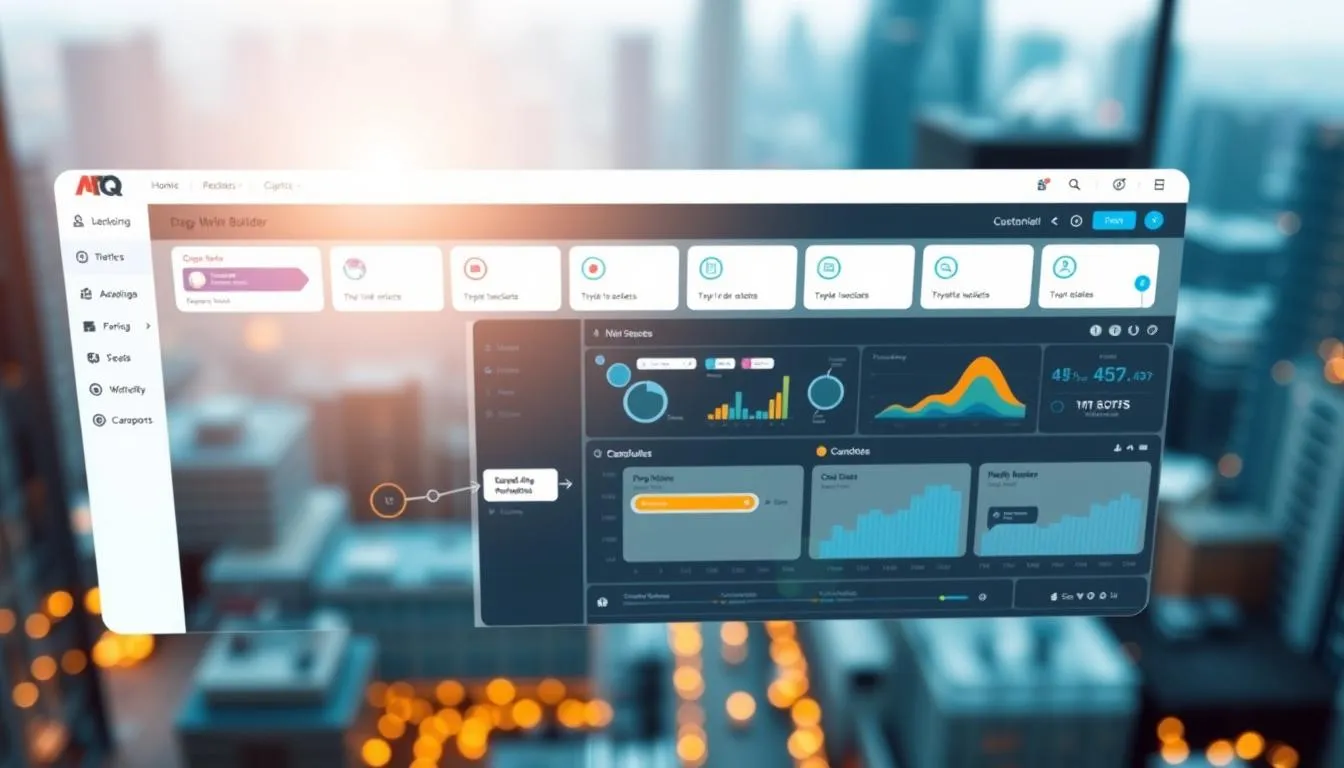“The first rule of any technology used in a business is that automation applied to an efficient operation will magnify the efficiency. The second is that automation applied to an inefficient operation will magnify the inefficiency.” – Bill Gates. This insight perfectly frames why today’s adaptive systems matter more than ever.
Traditional automation tools follow fixed rules, like traffic lights changing at set intervals. But modern solutions think like a seasoned traffic controller – analyzing real-time patterns, adjusting flow dynamically, and learning from every decision. Over half of organizations now explore these smarter approaches, with KPMG reporting 51% actively testing them for tasks ranging from customer service to content creation.
What makes this shift revolutionary? Instead of coding endless “if-then” scenarios, teams can now build systems that reason through challenges independently. These platforms handle complex tasks by combining machine learning with user-friendly interfaces. They adapt to feedback, recall past interactions, and select the best tools for each job – all without requiring technical expertise.
Key Takeaways
- Modern automation evolves beyond rigid rules to adaptive decision-making
- 51% of companies now test intelligent systems for daily operations
- New platforms learn from experience and improve over time
- Complex tasks get automated through visual interfaces anyone can use
- Businesses report measurable gains in productivity and cost savings
Introduction to the No-Code AI Workflow Revolution
Imagine giving your team a digital assistant that learns while it works. Modern systems analyze information like seasoned experts, adapting to new challenges without constant supervision. This shift moves beyond rigid templates to dynamic solutions that grow with your business.
Overview of Visual Development and Smart Integration
Traditional systems operate like recipe followers – precise but inflexible. New platforms combine visual builders with decision-making engines. They handle multi-step tasks through contextual analysis rather than fixed commands.
Take lead management as an example. Advanced tools can research prospects, verify details across platforms, and craft tailored messages. This approach reduces manual work while maintaining personalization at scale.
Why Intelligent Systems Matter Now
Businesses face mounting pressure to deliver faster results with fewer resources. Adaptive solutions help teams manage complex processes without coding expertise. They learn from each interaction, improving outcomes through accumulated experience.
Machine learning transforms basic automation tools into strategic partners. These systems process real-time data, make informed choices, and adjust expert Optimize Your ComfyUI strategies conditions change. The result? Operations that stay efficient even when priorities shift overnight.
Understanding the Benefits of No-Code AI Workflow
Businesses gain immediate advantages when adopting intelligent automation platforms. These solutions transform how teams operate by combining simplicity with powerful capabilities – no advanced skills required.

Enhanced Productivity and Efficiency
Automating repetitive tasks like data entry or customer query sorting frees up hours weekly. Teams redirect this time toward strategic initiatives – analyzing trends or improving client experiences. One marketing agency reported completing projects 40% faster after implementing these workflow automation solutions.
Advanced platforms handle multi-step processes with precision. They cross-reference information across systems, flag inconsistencies, and generate reports automatically. This reduces errors while maintaining consistent output quality – crucial for scaling operations.
Cost Savings and Lower Technical Barriers
Subscription models eliminate six-figure development costs. Most services start under $500/month – less than hiring a junior developer. A recent case study showed a retail company cut operational expenses by 62% within three months of adoption.
Visual interfaces let anyone design custom systems through drag-and-drop components. You don’t need coding expertise to build tools that handle inventory tracking or lead scoring. This accessibility empowers departments to solve challenges without IT bottlenecks.
How AI Transforms Traditional Workflow Automation
Legacy systems operate like clockwork – precise but brittle when faced with unexpected changes. Modern platforms transform rigid procedures into fluid problem-solving engines. They analyze variables in real-time, adjusting strategies like seasoned project managers handling shifting priorities.

From Scripted Commands to Dynamic Problem-Solving
Traditional systems stumble when tasks require creative thinking. New approaches break complex operations into logical steps. Planning a corporate event? These tools might:
- Compare venue availability across booking platforms
- Analyze attendee preferences from past surveys
- Adjust budgets based on real-time pricing data
This method maintains structure while allowing flexibility. Platforms remember what worked last quarter and apply those lessons automatically.
Smart Connections and Information Synthesis
Modern solutions excel at combining multiple data streams. Function calling lets systems:
| Capability | Traditional Tool | Modern System |
|---|---|---|
| Data Retrieval | Manual searches | Auto-query 5+ sources |
| Error Handling | Flag issues | Self-correct using history |
| Personalization | Basic templates | Adapt messages using machine learning |
Memory systems track conversation threads across weeks. Short-term recall ensures consistency during active processes, while long-term patterns inform strategic improvements. This dual-layer approach helps teams scale operations without sacrificing quality.
Selecting the Right Tools for Your No-Code AI Workflow
Choosing digital tools resembles a chef selecting ingredients – the right combination creates magic. Start by defining your main objective. Are you streamlining client onboarding? Automating social media posts? Each task demands specific features.

Key Criteria: Use Case, Scalability, and Pricing
Specialized platforms often outperform generalists for niche tasks. Marketing teams might prefer tools with built-in campaign analytics, while sales groups need CRM integrations. Always test how well solutions handle your core processes.
Technical requirements vary widely. Some services work like puzzle pieces – snap components together visually. Others need basic scripting knowledge but offer deeper customization. Match complexity to your team’s comfort level.
Platform Showdown: Features Face-to-Face
Four leaders dominate this space, each with unique strengths:
| Service | Best For | Standout Feature |
|---|---|---|
| Zapier | App connections | 7,000+ integrations |
| n8n | Tech teams | Self-hosted options |
| Make | Visual builders | Drag-drop scenarios |
| Tray.io | Natural language | AI-assisted setup |
Pricing models differ dramatically. Some charge per automated action, others by user count. Watch for hidden costs like premium connectors or storage fees. A platform costing $300/month could save $15,000 annually in labor – calculate your break-even point.
Practical Ways to Integrate AI with No-Code Solutions
Modern teams need adaptable solutions that evolve with user needs. Platforms like Bubble and Zapier turn complex processes into drag-and-drop experiences. Let’s explore how to enhance operations without writing a single line of code.
Building Custom Bots and Chat Interfaces
Chat tools like Typeform let anyone create smart conversational systems. These apps handle customer inquiries 24/7 while collecting valuable feedback. For example:
- Landbot’s interface adapts responses based on user input
- Chatfuel connects Messenger bots to CRM systems
- Drift remembers conversation history for personalized support Check out our guide on Streamline AI Data Cleaning.
One e-commerce store reduced response times by 68% using these tools. Their bot now resolves common shipping questions instantly.
Automating Task Management and Customer Engagement
Smart integrations transform project management. Tools like Trello sync with Gmail’s Smart Reply to automate updates. Teams get:
| Feature | Benefit |
|---|---|
| Auto-scheduling | Meetings booked based on availability |
| Resource allocation | Tasks assigned by skill match |
| Deadline tracking | Alerts for overdue items |
A marketing agency streamlined client reports using Airtable. Their system now pulls data from 12+ sources automatically. Customer satisfaction scores jumped 22% with faster turnaround times.
Step-by-Step Guide to Building Your No-Code AI Workflow
Building efficient systems resembles constructing a house – start with a blueprint before laying bricks. Successful implementation begins with understanding what needs fixing and ends with continuous refinement. Let’s break down the essentials.
Planning and Defining Your Automation Needs
Identify repetitive tasks draining your team’s time. Common targets include:
- Data transfers between platforms
- Customer follow-up sequences
- Report generation
Map your current process using flowcharts. Highlight bottlenecks like manual approvals or version conflicts. Set measurable goals – “Reduce email response time to 2 hours” works better than “Improve communication.”
Implementing and Testing Your Workflow
Start small with automation software like Zapier. Connect your email to Slack for instant notifications. Test this tool combination for a week before scaling.
| Stage | Action | Success Metric |
|---|---|---|
| Setup | Connect 2 apps | 90% data accuracy |
| Testing | Run 50 transactions | |
| Launch | Full integration | 40% time saved |
Monitor performance weekly using built-in analytics. Adjust triggers and actions based on real-world results. Remember – even the best workflow builder needs occasional tweaks.
Optimizing Your Workflow for Success
Perfecting your operations isn’t a one-time project—it’s a living system that evolves. Think of it like nurturing a garden: you plant smart solutions, then help them grow smarter through regular care.
Continuous Improvement Through Feedback and Learning
Great systems get better with use. Platforms now track every interaction, remembering what works and adjusting tactics. Short-term memory maintains consistency during active tasks, while long-term patterns inform strategic upgrades. Learn more about proven Improve Your Site methods.
Set weekly review sessions to analyze performance data. A/B test different approaches for routine processes. Teams that refine their methods quarterly see 31% faster task completion rates.
Intelligent Tool Selection and Adaptive Processes
Your toolkit should grow as your needs change. Prioritize platforms offering built-in analytics and flexible connectors. One logistics company improved delivery accuracy by 44% after switching to modular automation tools.
Conduct tool audits every six months. Look for solutions that simplify complex processes without rigid templates. The best systems adapt to your team’s rhythm, not the other way around.
By combining smart decisions with responsive technology, you create operations that scale effortlessly. Measurable gains become routine when improvement is part of the workflow itself.
FAQ
What makes AI-driven automation different from traditional workflow tools?
Unlike rule-based systems, AI-powered tools like Zapier or Make.com adapt to data patterns, learn from user behavior, and handle complex tasks like sentiment analysis or predictive decisions without manual coding.
Can I integrate AI into my existing apps without technical skills?
Yes! Platforms such as Tray.io and n8n offer drag-and-drop interfaces to connect services like CRM systems, email marketing tools, or databases. Pre-built templates and APIs simplify adding smart features like chatbots or data analysis.
How do no-code platforms reduce costs for businesses?
They eliminate the need for developers by letting teams build workflows independently. For example, automating customer support with tools like Chatfuel cuts response times and reduces staffing expenses while scaling operations.
Which platforms are best for scaling automated workflows?
Zapier supports 5,000+ app integrations for small tasks, while Make.com and Tray.io handle large-scale processes with advanced logic. Evaluate pricing tiers, data limits, and enterprise-grade security to match your growth goals.
How can I ensure my automated workflows stay efficient over time?
Use platforms with analytics dashboards, like n8n, to monitor performance. Regularly update triggers or actions based on user feedback and leverage AI-driven insights to refine processes like lead scoring or inventory management.
Are there limitations to what no-code AI tools can achieve?
While they excel at tasks like form processing or sales funnel automation, highly custom algorithms may still require coding. However, tools like Google’s AutoML or Microsoft Power Apps bridge many gaps with pre-trained models.
What industries benefit most from AI-powered workflow automation?
E-commerce uses it for personalized recommendations, healthcare for patient data sorting, and marketing for campaign optimization. Even nonprofits automate donor engagement using platforms like Airtable and Integromat.
